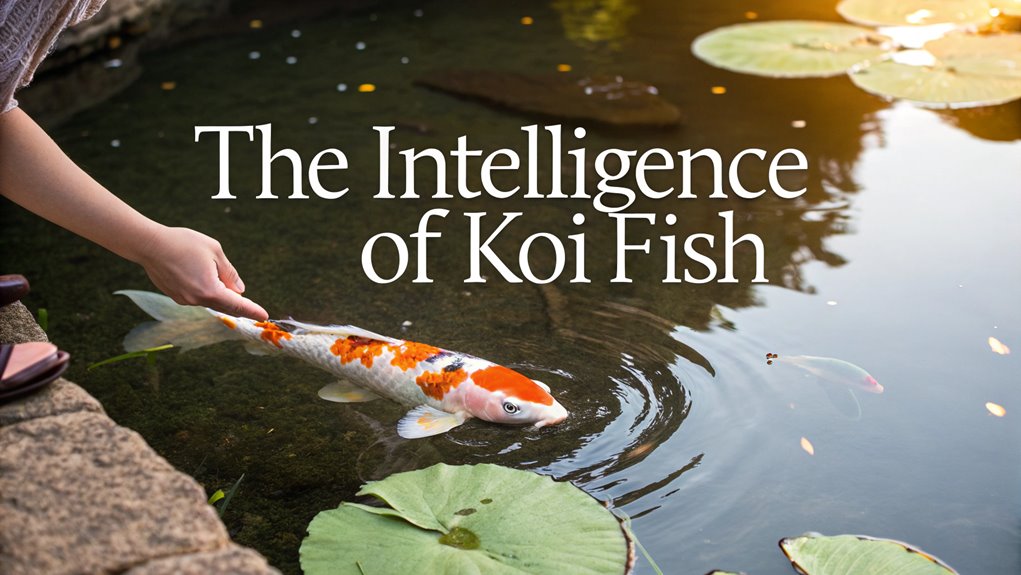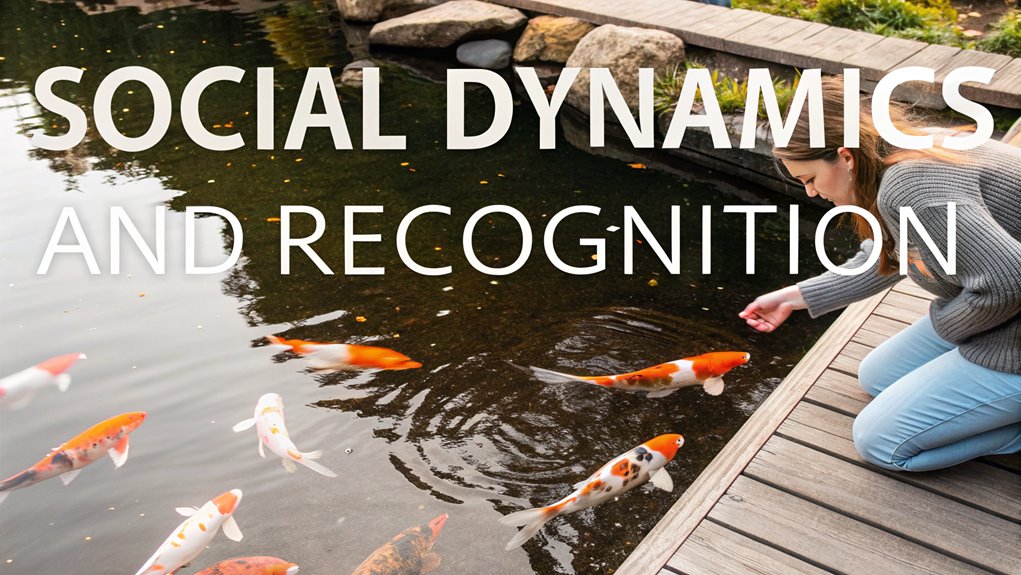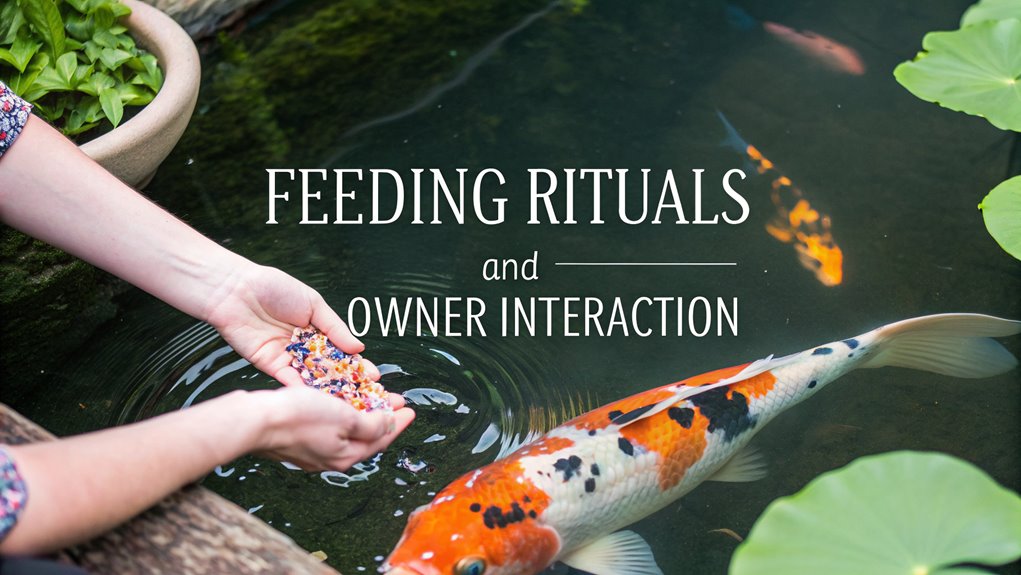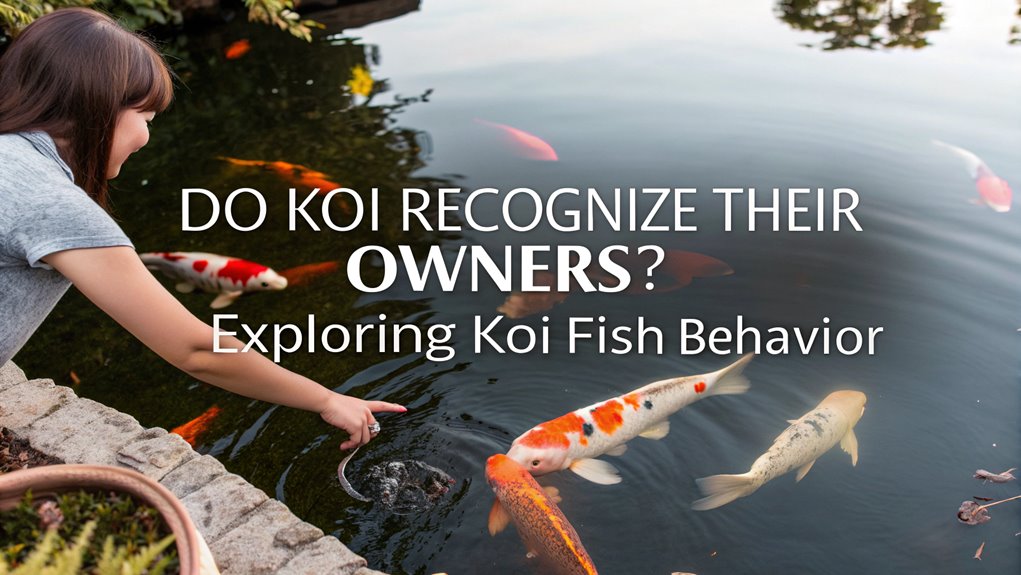Koi fish can indeed recognize their owners through consistent interaction and feeding routines. They demonstrate intelligence by associating your presence with food and responding eagerly when they see you. You’ll notice their anticipation as they swim to the surface, indicating a level of trust and recognition. Regular hand feeding enhances this bond, offering opportunities to observe their behavior closely. Understanding koi behavior further unveils the intricate connections you can build with these fascinating creatures.
Key Facts Summarized
- Koi recognize their owners and associate them with feeding, swimming eagerly to the surface in anticipation.
- They demonstrate cognitive awareness by learning to recognize sounds and feeding tools used by their owners.
- Regular feeding routines foster trust and recognition, as koi respond to familiar faces.
- Social bonding with humans is observed through gentle nudging behavior and engagement during feeding.
- Consistent human interaction with koi reduces fear and increases comfort, promoting recognition over time.
The Intelligence of Koi Fish

Although koi fish are often admired for their vibrant colors and graceful movements, their intelligence is equally noteworthy. Understanding koi reveals that their cognitive capabilities extend beyond mere instinct.
These fish can recognize their owners, associating their presence with feeding habits. You’ll find that koi swim eagerly to the surface when you approach, anticipating food. This behavior demonstrates their ability to remember specific cues and patterns.
Moreover, koi can adapt their actions by learning from experiences, such as recognizing the sound of your voice or identifying feeding implements. Their playful interactions during feeding suggest cognitive awareness, as they engage in activities that indicate both intelligence and emotional depth.
Through observing koi, you gain insight into their remarkable mental faculties.
Social Dynamics and Recognition

Koi fish exhibit fascinating social dynamics and recognition abilities that go beyond simple feeding interactions. You’ll notice how koi swim eagerly to the surface upon recognizing familiar faces, demonstrating their remarkable recognition skills.
Their social dynamics are evident as they form bonds with both humans and fellow koi. Regular feeding routines aren’t just about sustenance; they’re integral to fostering recognition and trust.
Individual personalities influence how koi engage with you, with some more eager than others. Gentle nudging behavior among koi indicates social bonding, highlighting their complex social dynamics.
Feeding Rituals and Owner Interaction

How do koi fish develop such a strong connection with their owners? They often associate human presence with feeding times, swimming eagerly to the surface. This consistent interaction reinforces their recognition and trust.
By maintaining regular feeding routines, you can enhance this bond, as koi begin to expect your presence and associate it with positive experiences. Hand feeding not only strengthens this relationship but also offers you a chance to closely monitor their behavior for any potential health issues. Additionally, consistent observation during feeding allows you to detect any signs of stress or illness, ensuring their well-being.
Observing their eating habits and physical condition during these interactions is crucial for maintaining their overall health. Positive feeding experiences ensure koi remain socially engaged and comfortable, further deepening their connection with you as their caregiver and provider.
Communication Methods in Koi
Have you ever wondered how koi communicate with their environment and each other? Koi utilize a variety of communication methods that reveal much about their understanding of koi dynamics.
Through body language, they express emotions: relaxed koi display graceful swimming, while stress manifests in erratic movements. Recognizing their owners, koi often swim to the surface, associating humans with feeding and safety.
Social bonding behaviors, such as gentle nudging, indicate recognition and strengthen group interactions. Vocalizations, like low-pitched sounds, convey excitement or agitation, crucial for interpreting their emotional state.
Touch interactions, such as brushing against hands, underscore the importance of gentle contact in building trust. Observing these behaviors enhances our comprehension of koi communication intricacies. Additionally, maintaining healthy habitats is vital for ensuring koi thrive and interact positively.
Trust Building With Consistent Care
Establishing trust with koi fish requires consistent care and interaction, fostering a bond that benefits both the fish and their caregiver.
Regular feeding is crucial in developing this trust, as koi begin to associate you with positive experiences, such as nourishment. This association enhances the well-being of your koi by promoting a sense of security and comfort in their environment.
Be patient, as trust doesn’t form overnight; koi need time to adapt to frequent human presence. Engage gently and often, letting them grow accustomed to your interactions.
Watch their behavior during feeding times; more relaxed and social interactions indicate growing trust. Additionally, maintaining water quality is vital to ensure a healthy environment that supports the trust-building process.
The bond you build through consistent care enriches your experience, creating a harmonious relationship with your koi.
Observing Koi Behavior and Mood
Why is observing koi behavior and mood essential for their care? Monitoring koi fish behavior helps you detect changes in their health and social dynamics.
Recognizing aggressive behavior or the use of hiding spots can signal stress or discomfort, perhaps due to environmental shifts or social disruptions. When you see koi swimming erratically or flicking, it might indicate distress.
On the other hand, relaxed swimming patterns and approaching you at feeding times suggest they feel secure and recognize you as their caregiver.
Environmental Factors Affecting Recognition
When caring for koi, understanding how environmental factors influence their ability to recognize you as their owner is crucial.
Water quality in koi ponds directly affects fish health and interaction levels. High-quality water ensures koi are active and responsive, while poor conditions can lead to stress and hinder recognition.
Stress reduction is essential; overcrowding or dirty water causes koi to hide or become lethargic, impacting their ability to form connections.
To enhance recognition:
- Maintain optimal water quality: Regular testing and filtration.
- Provide a clean environment: Regular pond cleaning to remove debris.
- Include hiding spots: Plants and rocks create safe areas.
- Ensure stable conditions: Consistent temperature and pH levels. Additionally, monitoring ammonia levels is critical to prevent toxicity and promote overall koi health.
Enhancing Bonding Through Hand Feeding
Hand feeding koi presents a unique opportunity to enhance bonding between you and your fish, as this method capitalizes on their natural behaviors and instincts. By associating you with feeding times, koi develop trust, resulting in more relaxed and social behaviors. Offering high-quality treats like Manda Fu Koi Food stimulates their foraging instincts, promoting activity and health. Regular hand feeding allows for close observation, providing insights into their well-being. Incorporating high-quality food into their diet can further support their growth and vibrant colors.
| Strategy | Benefit |
|---|---|
| Consistent Routine | Strengthens bond |
| High-Quality Treats | Stimulates natural instincts |
| Close Observation | Monitors health and behavior |
| Social Interaction | Encourages relaxed behavior |
Establishing a consistent feeding routine fosters positive associations, reinforcing the bond between you and your koi. As you integrate hand feeding into your routine, you’ll notice a deeper connection with your aquatic companions.
Signs of Stress and Comfort in Koi
Having established a strong bond with your koi through hand feeding, it’s important to recognize the indicators of stress and comfort in these vibrant creatures.
Koi show comfort by swimming gracefully and eagerly approaching you during feeding times. However, stress can manifest as erratic swimming, hiding, or flicking against surfaces. These behaviors often signal environmental issues such as poor water quality, necessitating immediate attention.
To ensure your koi’s well-being, focus on maintaining a healthy pond environment. Overcrowding leads to aggression and stress, so provide ample space and hiding spots.
Key signs to monitor:
- Graceful swimming: Indicates comfort and familiarity.
- Erratic movements: Suggests stress, possibly from poor conditions.
- Hiding behavior: Signals discomfort or fear.
- Flicking against surfaces: Points to environmental stressors.
Creating a Harmonious Pond Environment
While crafting a harmonious pond environment, focus on providing ample space and maintaining optimal water conditions to support your koi’s health and comfort.
Each koi thrives best with at least 500 gallons of water, minimizing stress and aggression. Pond owners should regularly test for pH, ammonia, nitrite, and nitrate levels, as suboptimal levels can lead to health issues like lethargy.
Consistent water temperatures between 65°F and 75°F are vital, as fluctuations can stress koi. Incorporate rocks and aquatic plants to offer hiding places, promoting social interaction and reducing tension.
Environmental enrichment, through varied pond features and vegetation, encourages natural behaviors and strengthens social bonds among koi, enhancing their quality of life and ensuring a balanced ecosystem.
Frequently Asked Questions
Do Koi Fish Recognize Their Owners?
You can observe that koi fish recognize their owners through consistent interaction. They associate your presence with feeding cues, often swimming to greet you. Regular engagement and hand-feeding help strengthen this bond, showcasing their social and intelligent nature.
Does Anyone Remember You?
Like stars in a constellation, your interactions create patterns in others’ memories. They remember you through consistent behavior and shared experiences. You leave an imprint on their cognitive map, much like how creatures recognize familiar signals over time.
How Can You Tell a Koi Fish Likes You?
You’ll know a koi fish likes you by observing its behavior. It swims energetically to the surface, nudges gently during feeding, and may follow your movements around the pond, indicating recognition and a positive bond.
How Do Koi Fish Show Affection?
Koi fish display affection like a gentle dance, nudging or brushing against your hand. Through consistent feeding routines, they recognize you, swimming excitedly and vocalizing softly, indicating trust and strengthening the social bond you share.
Conclusion
You’ve now swum through the depths of koi intelligence and behavior, uncovering how these vibrant fish recognize their human companions. With consistent care and hand feeding, you can build trust, turning your pond into a harmonious oasis. Recognize the signs of stress and comfort, and you’ll fine-tune your interactions, making each feeding a dance of mutual appreciation. Remember, your koi are like living watercolors in a pond of possibilities, responding to your presence like ripples on a serene lake.

